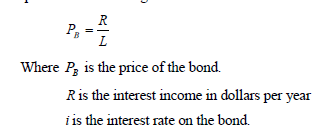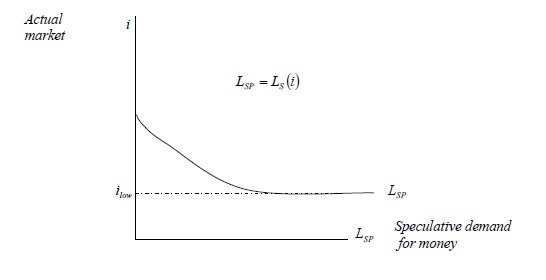-In the general theory, Keynes referred to the speculative motive as part of a
household’s liquidity preferred, since money is the most liquid assets that the
household can hold.
-Depending on the household’s preference between either holding bonds or holding
money, one can construct what has been termed a speculative demand for money
curve for the economy.
-We first need to explore the relationship between the prices of a marketable bond and
the interest rate on that bond because that relationship is fundamental to the
development of a speculative demand for money curve.
-For a simple example we choose a type of bond called a consol, which has no
maturity date or redemption value, but which pays certain number of dollars (R) per
year. The only way of converting the consol into money is for one speculator to sell
to another speculator in the bond market.
-The price of the bond is given as

There exists an inverse relationship between the price of the bond and the interest rate
on bond. The higher the price of the bond, the lower the interest rate, and vice versa.
Note that the construction of the speculative demand for money curve is based on
fluctuations in the price of bonds and the associated market interest rates.
-The choice between holding idle money balance and holding bonds depends on the
household expectation about the future movement of the market rate of interest.
-Each household would have formed a nation about what it considers the normal rate
of interest (or normal bond price) based on past experiences with the bond market.
-If the actual rate of interest currently varies from the normal rate of interest, the
household would hold the belief that the actual rate of interest will return to the
normal rate of interest in the future.
-If the actual rate of interest (say, 10%) were above the normal rate of interest (say,
8%) the household would expect the actual rate of interest to fall (to 8%) and would
therefore expect the price of bonds to rise.
-In this case the household waiting to make a capital gain would invest in bonds and
would not hold idle speculative money balance.
-However, if the actual rate (say, 6%) were below the normal rate (say,8%) the
household would expect the actual rate (say,6%) to rise to the normal rate.
-In this case, bond prices would fall and the household not wishing to experience a
capital loss on its assets would liquidate its bonds and would hold as an asset would
liquidate its bonds and would hold as an asset in its portfolio only idle speculative
money balance.
-Consider two extreme cases.
Case 1:
actual interest is higher than all the group normal rates of interest.
All groups would certainly expect the price of bond to rise since the price of bond is
currently at its lowest possible level.
All speculators will prefer holding bonds and not speculative money balances.
Case 2:
actual rate of interest is at its lowest and below all groups normal rate of interest.
The price of the bond is at its highest and all households that speculate in the bonds
market expects the bonds price to decline in future as actual interest rate rises towards the
normal rate of interest.All household will, therefore, hold idle money balance. In effect there is absolute liquidity.
The absolute liquidity position has been termed a Keynesian liquidity trap
The inverse relationship between actual market rate of interest and the speculative money
demand is presented in the figure below

The liquidated trap is illustrated by the horizontal portion of the speculative demand
for money curve. Note that the liquidity trap would be a phenomenon od a depression
and associated with high level of unemployment.
-Keynes’ total demand for money can be expressed as

Thus, the total demand for money depends on the level of income and the market rate
of interest.
sharon kalunda answered the question on
April 11, 2019 at 12:31